This dinner roll recipe took Chef Rachel Farnsworth over 5 years of testing to develop. It has since been enjoyed by millions of people around the world with thousands and thousands of rave reviews, heralded as the best dinner rolls on the internet. In addition to being published in her best-selling cookbook The Stay At Home Chef Family Favorites, this dinner roll recipe is used in restaurants and bakeries around the world. And now, it’s all yours!
Why Our Recipe
- Tried and true recipe for soft, fluffy, buttery dinner rolls worthy of a bakery every time.
- This recipe works for any skill level. Use a stand mixer or knead by hand.
- Make ahead instructions and freezer instructions included!
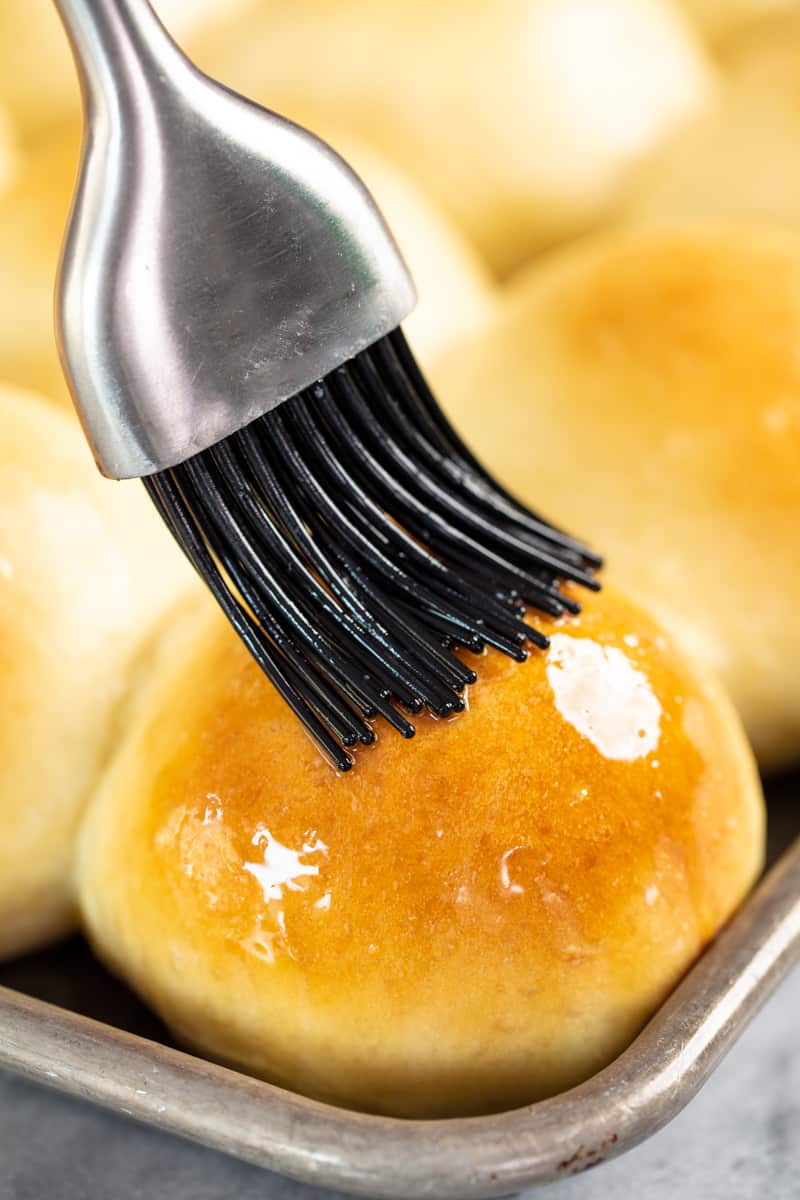
Whether you are new to bread making or an experienced baker, this recipe is sure to please. These homemade dinner rolls deliver bakery-quality results every single time. Whether you’re a seasoned baker or a beginner, this recipe has you covered. Use a stand mixer for convenience or knead the dough by hand if you prefer a more hands-on approach. You’ll get pillowy soft melt-in-your-mouth perfection either way!
Ingredient Notes
- Warm Milk: Make sure the milk is between 100°F to 110°F. Heat it on the stove or in the microwave. Use a thermometer for accuracy or test with your finger—it should feel warm but not hot. Use whole milk, 2% or 1% for best results. Skim and dairy milk alternatives can also work.
- Instant Dry Yeast: Instant yeast doesn’t need to be activated beforehand. If you only have active dry yeast, adjust the rising times slightly as noted in the instructions.
- Granulated Sugar: Yup, just regular old sugar. Brown sugar can also be used if you want to add in that hint of molasses.
- Salt: Stick with standard table salt for accurate measurements.
- Salted Butter: Make sure you use softened butter so it mixes in to the dough. If you only have unsalted butter, add an extra pinch of salt.
- Eggs: Grade AA large eggs will do.
- All-Purpose Flour: Start with 5 1/2 cups and gradually add more as needed. Bread flour can be used in the same amount for a slightly chewier texture, using the same amount.
- Melted Butter: Brushed on after baking for a shiny finish and buttery flavor.
No stand mixer? No Problem!
You can knead your dough by hand! Start out by stirring with a spoon until it becomes too difficult to stir. Turn the dough out onto a clean surface and knead it with your hands, gradually adding in more flour and folding, pressing, and working the dough (kneading) until you have a soft and smooth dough ball that is tacky, but not sticky enough to stick to your hands.
Active Dry Yeast Vs Instant
Instant dry yeast can be added straight to dry ingredients and doesn’t require any waiting period or proofing. It also rises a bit quicker. Active dry yeast is a bigger size of granule and generally needs to be dissolved in a liquid before adding to a recipe. It activates a bit slower so expect 10-15 minutes extra in rising time.
Go by Feel
The exact amount of flour you add in bread making can vary a great deal so it’s important to go by feel. I like to say you can feel a soft roll just by touching the dough. The dough should be smooth and slightly tacky, but still very soft and pliable. If it is sticking to your hands or the sides of the bowl, you need more flour. If you add too much flour and the dough stiffens, your rolls will also get a little stiff so always add additional flour a small amount at a time.
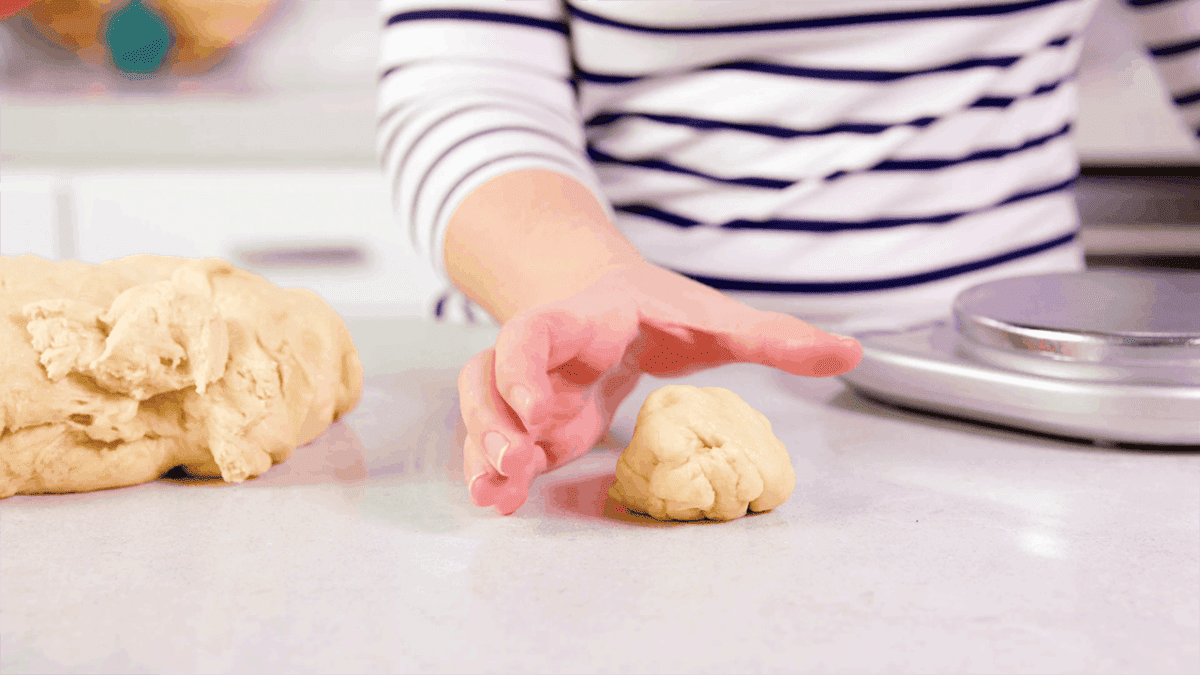
Pro Tip: Equal Size Rolls
The best way to ensure that your rolls are equal in size is to weigh them. Weigh the entire batch of dough using a kitchen scale and divide that weight by 24. This will give you your target weight for each roll. Usually, this is somewhere around 2.5 ounces.
Shaping Rolls
Once you have your dough divided into 24 pieces you can shape your rolls. Place your hand into a cupping shape parallel to a clean countertop. Place the dough ball between the palm of your hand and the countertop. Roll the dough in a circular motion between your palm and the countertop for approximately 30 to 45 seconds until you have a smooth, round ball.
Measuring Flour
The flour you buy at the store these days is generally pre-sifted. There is no need to sift your flour. I prefer the scoop and sweep method as it is ultra-convenient. Simply give your flour a fluff, use your measuring cup to scoop out the flour, and level off the top. Weighing your flour using a kitchen scale is the only way to ensure complete accuracy. Even then, bread making is both fickle and forgiving and the actual amount of flour you add can change just due to the humidity in the air. When making this roll recipe, it is best to go by the touch and feel of the dough. 1 cup of flour is approximately 125 grams.
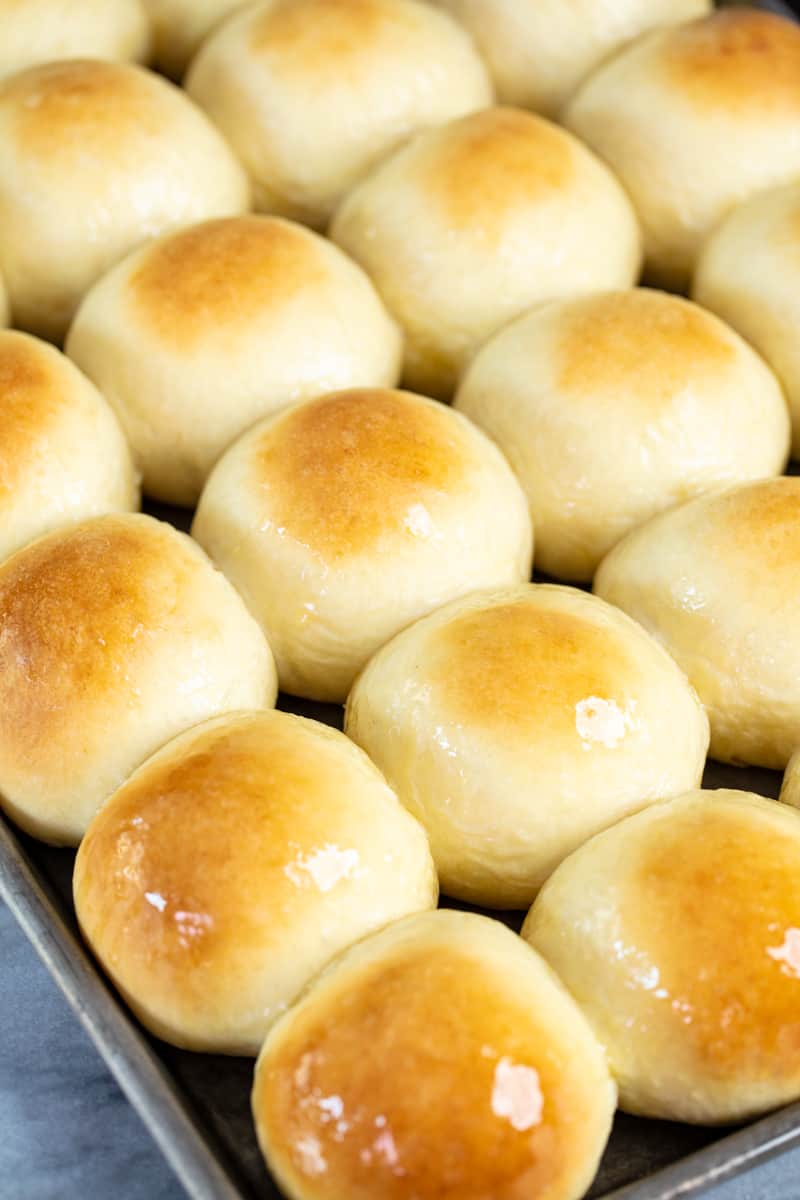
Freezer Instructions
You can freeze dinner rolls for later baking immediately after you shape them into rolls. When ready to eat, remove them from the freezer and allow to thaw and produce their second rise until double in size before baking. This can take anywhere between 1 to 2 hours, depending on the temperature in your home.
Make-Ahead Instructions
Need to make your dough ahead of time while you are busy doing other things? Make your dough as directed and let it rise for the initial 90 minutes. Shape the dough into rolls and place them on your baking sheet. Instead of letting them rise for an additional 60 minutes, cover the shaped rolls with plastic wrap and place the pan directly into the refrigerator. While it doesn’t stop it completely, the cool temperature of the fridge will slow the growth of your yeast. Your rolls will only rise slightly while refrigerated and you can hold them this way for up to 24 hours.
When ready to bake, remove them from the fridge and allow the rolls to rise at room temperature while your oven preheats, about 30 minutes. Continue to bake as directed.
Storage Instructions
Store in a plastic bag or airtight container at room temperature for up to 72 hours.
More perfect bread recipes…
Best Homemade Cinnamon Rolls Ever
2 hrs 14 mins
Ultimate Guide to Homemade Bread
3 hrs 25 mins
Homemade Breadsticks
1 hr 18 mins
Watch the video below where Rachel will walk you through every step of this recipe. Sometimes it helps to have a visual, and we’ve always got you covered with our cooking show. You can find the complete collection of recipes on YouTube, our Facebook Page, or right here on our website with their corresponding recipes.

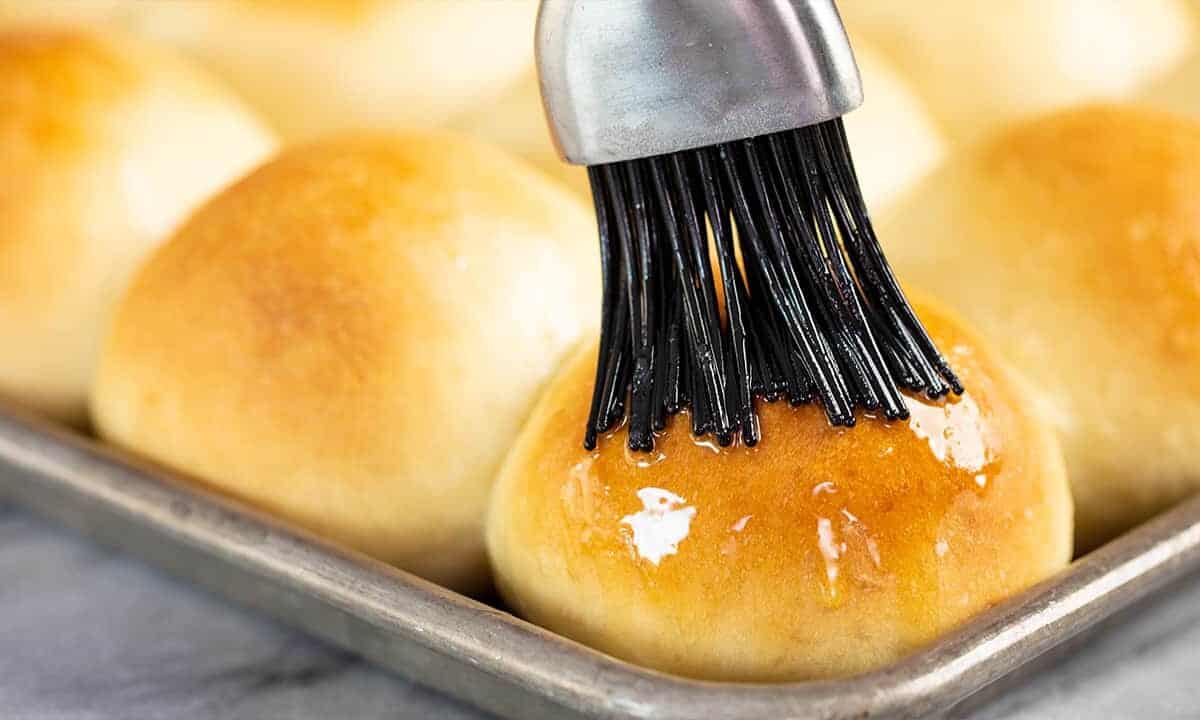
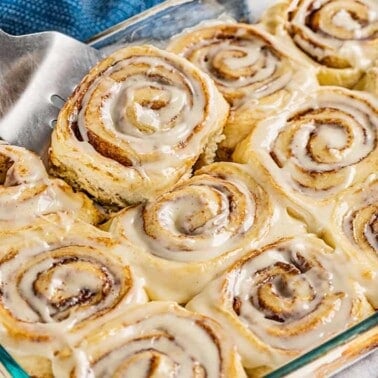
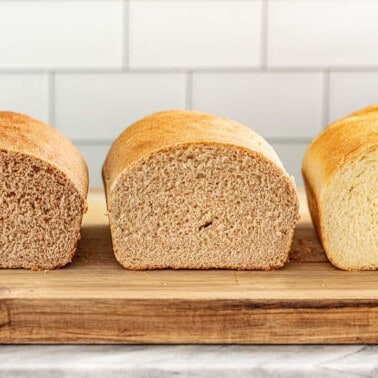
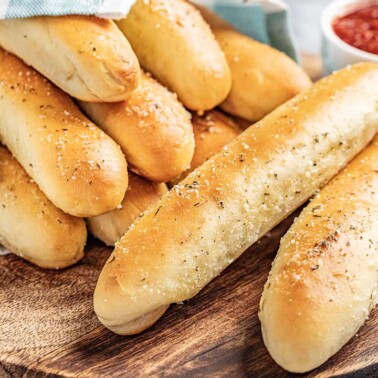
Great recipe! I made these rolls for Christmas. My family and guess loved them. The recipe will be made again and again. It is a keeper.
Will this recipe work with gluten free flour?
My wife has to be gluten free and really misses bread.
This is answered in the Frequently Asked Question section. I cannot vouch for any specific gluten free flour blends, but people have reported success with Cup for Cup. The result will be different from the original recipe for sure.
Help so far I have made this recipe three times and everyone absolutely loves them. I’ve never seen rolls go so fast. However, I have a problem. Everything thing works exactly as the recipe says and they are beautiful when I take them from the oven after 14 minutes but the rolls are still a bit doughy. What have I done wrong or do I just need to bake them longer? I live in Central Kentucky if that helps any.
Ovens can vary. You may just need a few more minutes.
These were perfection! Thank you for sharing your recipe and all the time you put into perfecting it.
I’m not sure what I did wrong – I followed the recipe to the letter. They came out bumpy and more like a biscuit. Was really disappointed as I had made them for a special dinner with friends.
I’d need more information to troubleshoot. Did you use self rising flour? Was your dough soft to the touch?
I tried this recipe last night and will make them again today. I cut the recipe in half and used the dough cycle on my bread machine. They came out delicious and maybe a little too fluffy, but I watched the video and will try rolling them into balls instead of simply dropping them onto the pan. This recipe is a keeper!
Hello. Can I let the rolls rise tonight and cook them tomorrow?
Why don’t you try chilling the dough after the first rise. Then shape them quickly and place on the sheet pan. Promptly cover and place sheet pan back in refrigerator. Then pull out in the morning and let rise then bake. You don’t know until you try!
Hi there! This is my first time attempting to make rolls. Do you start with the paddle attachment and switch to the dough rook? I wounder if the butter will get mixed in enough with just the dough hook? Thanks!
Nope, I only use the dough hook.
I make this recipe AT LEAST once a month and it has never failed me!!! Love, love, love this recipe!
I made these buns for a christmas potluck at my work and they were a HUGE hit! I had an old tried and true dinner roll recipe that I lost when my old computer died and I couldn’t find it again online, but this one is even better! I’m already making a double batch (one at a time though) for Christmas…and to have leftovers afterwards.
I know you posted in your FAQ that you can freeze after forming the dough into balls, but would it be okay to freeze the dough after the rolls have risen that next rising hour? That way I can pop them in real quick after they thaw out and be ready to go rather than wait for them to rise again. Mostly because I’m making one batch for my first christmas party, and a second batch for a dinner party.
Thanks again! Really truly fantastic rolls, excellent flavor and so so easy!!
You could certainly try!